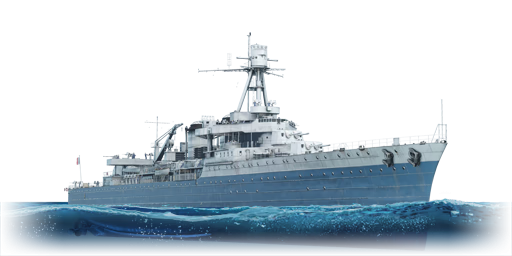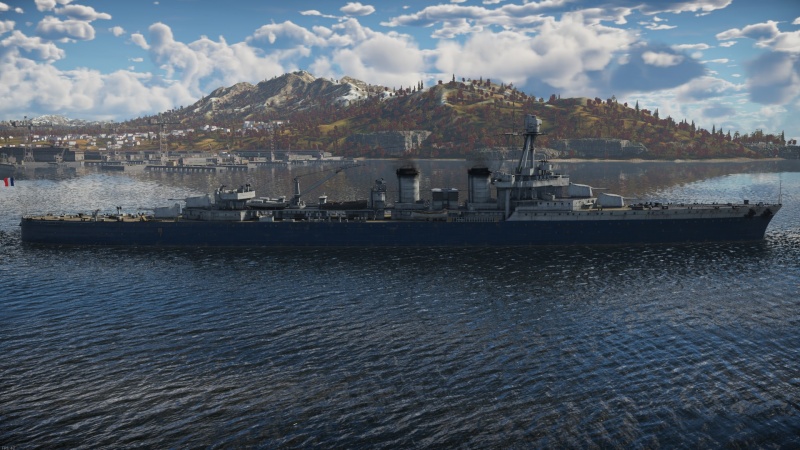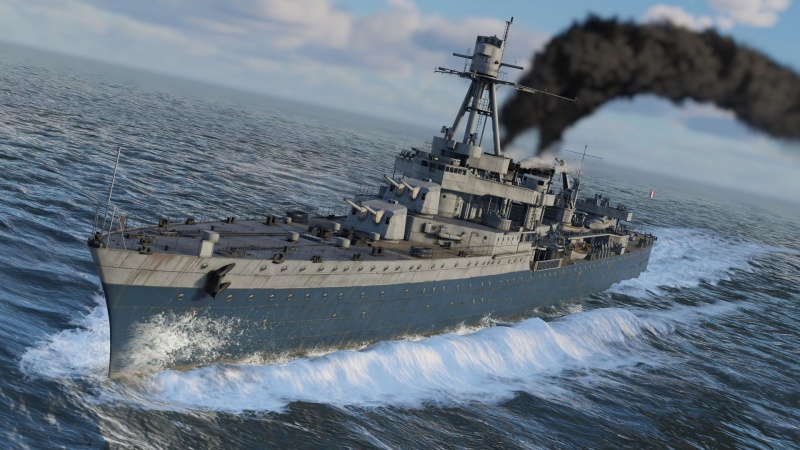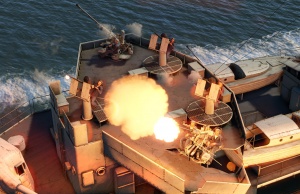Difference between revisions of "Duguay-Trouin"
Jareel_Skaj (talk | contribs) (Added images) |
|||
| (12 intermediate revisions by 7 users not shown) | |||
| Line 2: | Line 2: | ||
|code=fr_cruiser_dugauy_class_dugauy_trouin | |code=fr_cruiser_dugauy_class_dugauy_trouin | ||
|images={{Specs-Card-Image|GarageImage_{{PAGENAME}}.jpg|StoreImage_{{PAGENAME}}_001.jpg}} | |images={{Specs-Card-Image|GarageImage_{{PAGENAME}}.jpg|StoreImage_{{PAGENAME}}_001.jpg}} | ||
| − | |||
}} | }} | ||
== Description == | == Description == | ||
<!-- ''In the first part of the description, cover the history of the ship's creation and military application. In the second part, tell the reader about using this ship in the game. Add a screenshot: if a beginner player has a hard time remembering vehicles by name, a picture will help them identify the ship in question.'' --> | <!-- ''In the first part of the description, cover the history of the ship's creation and military application. In the second part, tell the reader about using this ship in the game. Add a screenshot: if a beginner player has a hard time remembering vehicles by name, a picture will help them identify the ship in question.'' --> | ||
| − | The '''{{Specs|name}}''' | + | '''Duguay-Trouin''', the namesake of [[Duguay-Trouin (Family)|her class]], was developed as the first French post-WW1 cruiser, launched on 14 August 1923. During the interwar period, she served as a convoy escort and gunnery training ship. In WW2, she unsuccessfully attempted to intercept [[Admiral Graf Spee|Deutschland-class]] ships. After the French surrender, she joined Force X and became interned at Alexandria. After [[wikipedia:Case_Anton|Case Anton]], she joined Allied forces with the rest of Force X, and in 1943 underwent a refit. In 1944, she carried troops between Algeria, Corsica, and southern Italy. Following that, she participated in [[wikipedia:Operation Dragoon|Operation Dragoon]] - amphibious landings in Southern France. Finally, she assisted Allied forces by bombarding Axis positions along the Italian coast. As the war ended, she took part in [[wikipedia:Sétif and Guelma massacre|Sétif, Guelma and Kherrata massacres]] and ferried troops between France and Algeria. After a refit, she assisted French forces during the [[wikipedia:Malagasy Uprising|Malagasy Uprising]] in Madagascar and, from late October 1948 till September 1951 she was stationed in Singapore during the [[wikipedia:First Indochina War|First Indochina War]]. She finally arrived back in Toulon in November 1951, after travelling over 70,000 nautical miles in the last 4 years. The vessel was so worn out that a decision was made to decommission her in March 1952 and sell her for breaking up in 1953, after serving one of the longest careers of the warships of her time. |
| + | |||
| + | The '''{{Specs|name}}''' was the second pre-order vessel, after [[Aigle]], announced for the introduction of the [[:Category:France ships|French navy]] to War Thunder. She was added to the game in [[Update "Sky Guardians"]]. Following the addition of the rest of the French navy in [[Update "La Royale"]] she was removed from the War Thunder store after the [[wt:en/news/8580-shop-war-thunders-birthday-sale-in-the-gaijinnet-store-en|11th Anniversary sale]]. She's best characterized by her excellent sustained firepower against enemy destroyers or light cruisers, along with relatively good survivability. She lacks the shells to counter heavily armoured warships or protection against a large volume of incoming High Explosive shells. Given the opportunity, she can be used to great effect in pushing the capture points or asserting the numeric advantage by dealing with the smaller vessels of the opposing force. | ||
== General info == | == General info == | ||
| Line 36: | Line 37: | ||
{{main|155 mm/50 model 1920 (155 mm)}} | {{main|155 mm/50 model 1920 (155 mm)}} | ||
| − | + | The {{PAGENAME}} features eight 155 mm model 1920 cannons, arranged in four twin turrets in A-Bs-Xs-Y. On paper, the gun offers one of the highest damage outputs at its the BR, comparable only with the late US destroyers. While the low rate of fire can be an issue under some circumstances, the size of the explosive filler in both: HE and SAP shells more than make up for it. The gun comes equipped with three types of shells: | |
* '''M1924 HE''' - large explosive filler, contact fuse, best against soft-skinned targets and external modules on the enemy warships | * '''M1924 HE''' - large explosive filler, contact fuse, best against soft-skinned targets and external modules on the enemy warships | ||
| Line 44: | Line 45: | ||
The ship lacks any dedicated anti-air shells or AP shells that could penetrate heavy armour. | The ship lacks any dedicated anti-air shells or AP shells that could penetrate heavy armour. | ||
| + | While in theory, each shell is quite powerful, the gun suffers from an abysmal vertical shell dispersions. The shell drop of each salvos is very inconsistent, with some dipped into the water 200 meters before the target, while othertimes it simply overshoot the enemy ship entirely. This will become apparent when firing from beyond 8 km range, as the shell would scattered wildly around the target, sometimes doesn't hit the enemy ship at all. | ||
{{:155 mm/50 model 1920 (155 mm)/Ammunition|155 mm M1924 HE, 155 mm M1924 HE-BF, 155 mm M1924 SAP}} | {{:155 mm/50 model 1920 (155 mm)/Ammunition|155 mm M1924 HE, 155 mm M1924 HE-BF, 155 mm M1924 SAP}} | ||
| Line 54: | Line 56: | ||
Having just two 75 mm secondary guns per side, equipped with an HE shells with contact fuse, secondary armament shouldn't be relied upon. They reload every 4 seconds, which is insufficient for easy dealing with manoeuvring torpedo boats. | Having just two 75 mm secondary guns per side, equipped with an HE shells with contact fuse, secondary armament shouldn't be relied upon. They reload every 4 seconds, which is insufficient for easy dealing with manoeuvring torpedo boats. | ||
| − | Mounts have an ability to engage targets | + | Mounts have an ability to engage targets up to 85° vertical guidance, what would make them perfect against high altitude bombers, but this is severely limited by the lack of {{Annotation|HE-TF|High-explosive with time fuse}} or {{Annotation|HE-VT|High-explosive variable time fuse}} shells. In effect the gunfire has primarily have a psychological effect against enemy airplanes, as the probability of directly hitting at ranges where 75 mm would provide an additional protection is negligible. |
| − | {{:75 mm/50 model 1922 (75 mm)/Ammunition|75 mm OEA Mle 1925}} | + | {{:75 mm/50 model 1922 (75 mm)/Ammunition|75 mm OEA Mle 1925, 75 mm HE-TF OEA Mle 1925}} |
=== Anti-aircraft armament === | === Anti-aircraft armament === | ||
| Line 75: | Line 77: | ||
'''Pros:''' | '''Pros:''' | ||
| − | * Very good damage output from the main guns | + | |
| + | * Very good damage output from the main guns, provided that most shell hits | ||
* Effective anti-air cover | * Effective anti-air cover | ||
* Good survivability with very well protected ammo racks | * Good survivability with very well protected ammo racks | ||
'''Cons:''' | '''Cons:''' | ||
| + | |||
* Very limited armour protection | * Very limited armour protection | ||
| + | * Horrible shell dispersion, especially at longer ranges (~8 km) | ||
| + | * Can be easily outgunned in uptiers due to slow rate of fire | ||
* Very limited capability to deal with a heavily-armoured target due to the lack of AP shells | * Very limited capability to deal with a heavily-armoured target due to the lack of AP shells | ||
* Lack of {{Annotation|HE-TF|High-explosive with time fuse}} or {{Annotation|HE-VT|High-explosive variable time fuse}} shells | * Lack of {{Annotation|HE-TF|High-explosive with time fuse}} or {{Annotation|HE-VT|High-explosive variable time fuse}} shells | ||
* No torpedoes | * No torpedoes | ||
| − | |||
== History == | == History == | ||
| Line 90: | Line 95: | ||
The Duguay-Trouin-class was developed from the 1915 proposal for a new class of cruisers, the first to be built domestically in France since 1906. Designated ''Project 171'' ships were originally to be much smaller and cheaper, armed with the 138.6 mm guns, but the reveal of the [[HMS Enterprise|British E-class]] along with the [[Omaha (Family)|American Omaha-class]] in 1920 forced French designers into a larger, better-armed and faster ships armed with the 155 mm guns. Just the increase in speed alone, from 30 to 34 knots, doubled the required shaft horse power from ~53 000 shp to ~100 600 shp. | The Duguay-Trouin-class was developed from the 1915 proposal for a new class of cruisers, the first to be built domestically in France since 1906. Designated ''Project 171'' ships were originally to be much smaller and cheaper, armed with the 138.6 mm guns, but the reveal of the [[HMS Enterprise|British E-class]] along with the [[Omaha (Family)|American Omaha-class]] in 1920 forced French designers into a larger, better-armed and faster ships armed with the 155 mm guns. Just the increase in speed alone, from 30 to 34 knots, doubled the required shaft horse power from ~53 000 shp to ~100 600 shp. | ||
| − | Typically for the Treaty cruisers it enjoyed a minimal protection, accounting for just 2% of displacement. Cruisers of the time were described as "eggshells armed with hammers", being able to stop WW1-era 4 inch guns, but inadequate for the guns of the interwar period. Cruisers of the time were designed to outrun the ships they couldn't outgun. That said though: Duguay-Trouin-class was built with survivability in mind. The double-shell hull was subdivided with 17 transverse watertight bulkheads. Each of the four boiler rooms enjoyed a fully redundant subsystems. Similarly steering gear was fully electrically powered, but it had a manual backup. Electrical systems were also highly redundant, with turbogenerators located in the aft engine room near rear turrets, central engine room and below the bridge superstructure. Generators could be run individually or coupled. Later ships of the class included an additional diesel generators for an even higher degree of redundancy. Petrol and aviation fuel was stored in a special isolated tanks high in the stern of the ship, ensuring that any damage to the tanks wouldn't impact the vessel. | + | Typically for the Treaty cruisers it enjoyed a minimal protection, accounting for just 2% of displacement. Cruisers of the time were described as "eggshells armed with hammers", being able to stop WW1-era 4 inch guns, but inadequate for the guns of the interwar period. Cruisers of the time were designed to outrun the ships they couldn't outgun. That said though: Duguay-Trouin-class was built with survivability in mind. The double-shell hull was subdivided with 17 transverse watertight bulkheads. Each of the four boiler rooms enjoyed a fully redundant subsystems. Similarly steering gear was fully electrically powered, but it had a manual backup. Electrical systems were also highly redundant, with turbogenerators located in the aft engine room near rear turrets, central engine room and below the bridge superstructure. Generators could be run individually or coupled. Later ships of the class included an additional diesel generators for an even higher degree of redundancy. Petrol and aviation fuel was stored in a special isolated tanks high in the stern of the ship, ensuring that any damage to the tanks wouldn't impact the vessel. |
The ship was praised for its excellent sea-keeping qualities, an exceptional turning circle of just 750 m at 28 knots, a low silhouette, spacious armoured bridge, along with the flexibility and reliability of the machinery. The key criticism of the vessel was its high centre of gravity once the fuel load was depleted, resulting in roll of up to 18° during turns. | The ship was praised for its excellent sea-keeping qualities, an exceptional turning circle of just 750 m at 28 knots, a low silhouette, spacious armoured bridge, along with the flexibility and reliability of the machinery. The key criticism of the vessel was its high centre of gravity once the fuel load was depleted, resulting in roll of up to 18° during turns. | ||
| Line 100: | Line 105: | ||
== Media == | == Media == | ||
<!-- ''Excellent additions to the article would be video guides, screenshots from the game, and photos.'' --> | <!-- ''Excellent additions to the article would be video guides, screenshots from the game, and photos.'' --> | ||
| − | + | ||
| + | ;Skins | ||
| + | |||
| + | * [https://live.warthunder.com/feed/camouflages/?vehicle=fr_cruiser_dugauy_class_dugauy_trouin Skins and camouflages for the {{PAGENAME}} from live.warthunder.com.] | ||
== See also == | == See also == | ||
| Line 106: | Line 114: | ||
* ''reference to the series of the ship;'' | * ''reference to the series of the ship;'' | ||
* ''links to approximate analogues of other nations and research trees.'' --> | * ''links to approximate analogues of other nations and research trees.'' --> | ||
| − | + | ||
| − | + | ;Related development | |
| − | * | + | |
| + | * [[Primauguet]] | ||
== External links == | == External links == | ||
| Line 122: | Line 131: | ||
* Jordan John and Jean Moulin. 2013. French Cruisers 1922-1956. Annapolis Maryland: Naval Institute Press. | * Jordan John and Jean Moulin. 2013. French Cruisers 1922-1956. Annapolis Maryland: Naval Institute Press. | ||
| + | {{ShipManufacturer Arsenal de Brest}} | ||
{{France light cruisers}} | {{France light cruisers}} | ||
{{France premium ships}} | {{France premium ships}} | ||
Revision as of 18:42, 19 June 2024
Contents
Description
Duguay-Trouin, the namesake of her class, was developed as the first French post-WW1 cruiser, launched on 14 August 1923. During the interwar period, she served as a convoy escort and gunnery training ship. In WW2, she unsuccessfully attempted to intercept Deutschland-class ships. After the French surrender, she joined Force X and became interned at Alexandria. After Case Anton, she joined Allied forces with the rest of Force X, and in 1943 underwent a refit. In 1944, she carried troops between Algeria, Corsica, and southern Italy. Following that, she participated in Operation Dragoon - amphibious landings in Southern France. Finally, she assisted Allied forces by bombarding Axis positions along the Italian coast. As the war ended, she took part in Sétif, Guelma and Kherrata massacres and ferried troops between France and Algeria. After a refit, she assisted French forces during the Malagasy Uprising in Madagascar and, from late October 1948 till September 1951 she was stationed in Singapore during the First Indochina War. She finally arrived back in Toulon in November 1951, after travelling over 70,000 nautical miles in the last 4 years. The vessel was so worn out that a decision was made to decommission her in March 1952 and sell her for breaking up in 1953, after serving one of the longest careers of the warships of her time.
The Duguay-Trouin-class, Duguay-Trouin, 1944 was the second pre-order vessel, after Aigle, announced for the introduction of the French navy to War Thunder. She was added to the game in Update "Sky Guardians". Following the addition of the rest of the French navy in Update "La Royale" she was removed from the War Thunder store after the 11th Anniversary sale. She's best characterized by her excellent sustained firepower against enemy destroyers or light cruisers, along with relatively good survivability. She lacks the shells to counter heavily armoured warships or protection against a large volume of incoming High Explosive shells. Given the opportunity, she can be used to great effect in pushing the capture points or asserting the numeric advantage by dealing with the smaller vessels of the opposing force.
General info
Survivability and armour
The ship has a significant advantage in terms of survivability due to the size of its crew, with 578 sailors it is one of the largest in the BR. The ammunition racks are located deep below the waterline and are protected by additional plating, which makes ammunition explosions very unlikely to occur. Moreover, the turrets and ammo elevators are equipped with 30 mm armour, which can reduce fragmentation damage caused by near-misses.
The ship's large size also serves as a form of protection as its hull is divided into 9 sections, a feature typically found on heavy cruisers, reducing damage from both torpedoes and bombs.
However, like other ships in its BR, the Duguay-Trouin does not have armour that can directly stop high-calibre SAP or HE shells. Typically for the light cruisers it is also unable to withstand damage from multiple enemy warships.
Mobility
The mobility can be described in one word: average. The rudder turn speed varies between 5.4 seconds (not upgraded) to 4.05 seconds (aced crew with maximum leadership), which is somewhat slower than most of the light cruisers of the BR when not upgraded, but the same as all the competitors when fully aced. Guns can easily keep up with the turn rate thanks to their high horizontal targetting speed.
| Mobility Characteristics | |||
|---|---|---|---|
| Game Mode | Upgrade Status | Maximum Speed (km/h) | |
| Forward | Reverse | ||
| AB | |||
| Upgraded | 71 | 34 | |
| RB/SB | |||
| Upgraded | 61 | 29 | |
Modifications and economy
Armament
Primary armament
The Duguay-Trouin features eight 155 mm model 1920 cannons, arranged in four twin turrets in A-Bs-Xs-Y. On paper, the gun offers one of the highest damage outputs at its the BR, comparable only with the late US destroyers. While the low rate of fire can be an issue under some circumstances, the size of the explosive filler in both: HE and SAP shells more than make up for it. The gun comes equipped with three types of shells:
- M1924 HE - large explosive filler, contact fuse, best against soft-skinned targets and external modules on the enemy warships
- M1924 SAP - good explosive filler, best against lightly-armoured targets, will dive into the ship to reach the internal modules
- M1924 HE-BF - smallest explosive filler of the three, base fuse, particularly good when hitting a highly angled target, will dive deeper into the ship bellows than SAP, but also is more prone to over-penetration and has less of a penetrative capability against a parallel target
The ship lacks any dedicated anti-air shells or AP shells that could penetrate heavy armour.
While in theory, each shell is quite powerful, the gun suffers from an abysmal vertical shell dispersions. The shell drop of each salvos is very inconsistent, with some dipped into the water 200 meters before the target, while othertimes it simply overshoot the enemy ship entirely. This will become apparent when firing from beyond 8 km range, as the shell would scattered wildly around the target, sometimes doesn't hit the enemy ship at all.
| Penetration statistics | |||||||
|---|---|---|---|---|---|---|---|
| Ammunition | Type of warhead |
Penetration @ 0° Angle of Attack (mm) | |||||
| 1,000 m | 2,500 m | 5,000 m | 7,500 m | 10,000 m | 15,000 m | ||
| M1924 HE | HE | 51 | 51 | 51 | 51 | 51 | 51 |
| M1924 HE-BF | HE | 87 | 78 | 64 | 53 | 45 | 34 |
| M1924 SAP | SAPBC | 142 | 126 | 104 | 87 | 73 | 55 |
| Shell details | ||||||||||||
|---|---|---|---|---|---|---|---|---|---|---|---|---|
| Ammunition | Type of warhead |
Velocity (m/s) |
Projectile mass (kg) |
Fuse delay (s) |
Fuse sensitivity (mm) |
Explosive mass (TNT equivalent) (kg) |
Ricochet | |||||
| 0% | 50% | 100% | ||||||||||
| M1924 HE | HE | 864 | 59 | 0 | 0.1 | 6.16 | 79° | 80° | 81° | |||
| M1924 HE-BF | HE | 870 | 56.5 | 0.015 | 7 | 2.9 | 79° | 80° | 81° | |||
| M1924 SAP | SAPBC | 870 | 56.5 | 0.01 | 7 | 3.67 | 48° | 63° | 71° | |||
Secondary armament
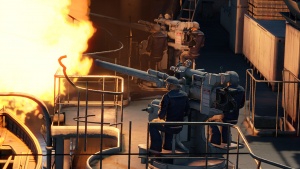
Having just two 75 mm secondary guns per side, equipped with an HE shells with contact fuse, secondary armament shouldn't be relied upon. They reload every 4 seconds, which is insufficient for easy dealing with manoeuvring torpedo boats.
Mounts have an ability to engage targets up to 85° vertical guidance, what would make them perfect against high altitude bombers, but this is severely limited by the lack of HE-TF or HE-VT shells. In effect the gunfire has primarily have a psychological effect against enemy airplanes, as the probability of directly hitting at ranges where 75 mm would provide an additional protection is negligible.
| Penetration statistics | |||||||
|---|---|---|---|---|---|---|---|
| Ammunition | Type of warhead |
Penetration @ 0° Angle of Attack (mm) | |||||
| 100 m | 1,000 m | 2,000 m | 3,000 m | 4,000 m | 5,000 m | ||
| OEA Mle 1925 | HE | 8 | 8 | 8 | 8 | 8 | 8 |
| HE-TF OEA Mle 1925 | HE-TF | 8 | 8 | 8 | 8 | 8 | 8 |
| Shell details | ||||||||||||
|---|---|---|---|---|---|---|---|---|---|---|---|---|
| Ammunition | Type of warhead |
Velocity (m/s) |
Projectile mass (kg) |
Fuse delay (m) |
Fuse sensitivity (mm) |
Explosive mass (TNT equivalent) (g) |
Ricochet | |||||
| 0% | 50% | 100% | ||||||||||
| OEA Mle 1925 | HE | 850 | 5.93 | 0 | 0.1 | 450 | 79° | 80° | 81° | |||
| HE-TF OEA Mle 1925 | HE-TF | 850 | 5.93 | 0 | 0.1 | 450 | 79° | 80° | 81° | |||
Anti-aircraft armament
The vessel comes with multiple anti-air guns spread all throughout the ship, giving it an excellent coverage of both: short-range 20 mm and medium-range 40 mm guns. The 40 mm in particular offer 360° degree horizontal and -7°/+90° vertical leaving no dead zones for the enemy dive bombers to approach. The 20 mm guns are limited to -3°/+65° vertical, offering the best defence to the port and starboard.
Usage in battles
The Duguay-Trouin is a very effective cruiser in its BR and lower, but has little means of responding against heavy cruisers from a higher BRs. It's a gun-centric ship, that can output a significant amount of damage even with the HE shells, but where it shines is the damage output from SAP shells compared to a similar shells from other vessels.
The ship is best used for pushing enemy points, out-ranging enemy destroyers and picking off problematic, but lightly-armoured targets. What it should avoid are direct exchanges of fire with the enemy heavy cruisers, or getting too close to the enemy ships armed with torpedoes, in particular Japanese Long Lance.
Pros and cons
Pros:
- Very good damage output from the main guns, provided that most shell hits
- Effective anti-air cover
- Good survivability with very well protected ammo racks
Cons:
- Very limited armour protection
- Horrible shell dispersion, especially at longer ranges (~8 km)
- Can be easily outgunned in uptiers due to slow rate of fire
- Very limited capability to deal with a heavily-armoured target due to the lack of AP shells
- Lack of HE-TF or HE-VT shells
- No torpedoes
History
The Duguay-Trouin-class was developed from the 1915 proposal for a new class of cruisers, the first to be built domestically in France since 1906. Designated Project 171 ships were originally to be much smaller and cheaper, armed with the 138.6 mm guns, but the reveal of the British E-class along with the American Omaha-class in 1920 forced French designers into a larger, better-armed and faster ships armed with the 155 mm guns. Just the increase in speed alone, from 30 to 34 knots, doubled the required shaft horse power from ~53 000 shp to ~100 600 shp.
Typically for the Treaty cruisers it enjoyed a minimal protection, accounting for just 2% of displacement. Cruisers of the time were described as "eggshells armed with hammers", being able to stop WW1-era 4 inch guns, but inadequate for the guns of the interwar period. Cruisers of the time were designed to outrun the ships they couldn't outgun. That said though: Duguay-Trouin-class was built with survivability in mind. The double-shell hull was subdivided with 17 transverse watertight bulkheads. Each of the four boiler rooms enjoyed a fully redundant subsystems. Similarly steering gear was fully electrically powered, but it had a manual backup. Electrical systems were also highly redundant, with turbogenerators located in the aft engine room near rear turrets, central engine room and below the bridge superstructure. Generators could be run individually or coupled. Later ships of the class included an additional diesel generators for an even higher degree of redundancy. Petrol and aviation fuel was stored in a special isolated tanks high in the stern of the ship, ensuring that any damage to the tanks wouldn't impact the vessel.
The ship was praised for its excellent sea-keeping qualities, an exceptional turning circle of just 750 m at 28 knots, a low silhouette, spacious armoured bridge, along with the flexibility and reliability of the machinery. The key criticism of the vessel was its high centre of gravity once the fuel load was depleted, resulting in roll of up to 18° during turns.
Interestingly ship design included space reserved for a passive hydrophone system along with the ultrasound pinger, but after the failed tests of the system on a smaller vessels, plans for the refit were abandoned.
The ship's namesake is René Duguay-Trouin (1673–1736), French privateer and Vice-Admiral. He became famous for his command during the War of the Spanish Succession, including the victory during the Battle at The Lizard, Battle of Rio de Janeiro and a capture of over 300 ships by 1709.
Media
- Skins
See also
- Related development
External links
- [Devblog] French Navy: light cruiser Duguay-Trouin
- [Wikipedia] Duguay-Trouin-class cruiser
- [Wikipedia] French cruiser Duguay-Trouin (1923)
- [uboat.net] FR Duguay-Trouin of the French Navy - French Light cruiser of the Duguay-Trouin class - Allied Warships of WWII
- [Navypedia] DUGUAY TROUIN light cruisers (1926)
- Jordan John and Jean Moulin. 2013. French Cruisers 1922-1956. Annapolis Maryland: Naval Institute Press.
| Arsenal de Brest | |
|---|---|
| Avisos | |
| Arras-class | Arras |
| Light Cruisers | |
| Duguay-Trouin-class | Duguay-Trouin · Primauguet |
| Heavy Cruisers | |
| Suffren-class | Colbert · Dupleix |
| Battleships | |
| Bretagne-class | Bretagne |
| Dunkerque-class | Dunkerque |
| France light cruisers | |
|---|---|
| Duguay-Trouin-class | Duguay-Trouin · Primauguet |
| Jeanne d'Arc* | |
| Emile Bertin* | |
| * Unique ship | |
| France premium ships | |
|---|---|
| Motor torpedo boats | VTB-9 · VLT-2 |
| Destroyers | Panthere · Tornade · Aigle · Le Triomphant |
| Light cruisers | Duguay-Trouin |
| Heavy cruisers | Dupleix |
| Battleships | Courbet |


